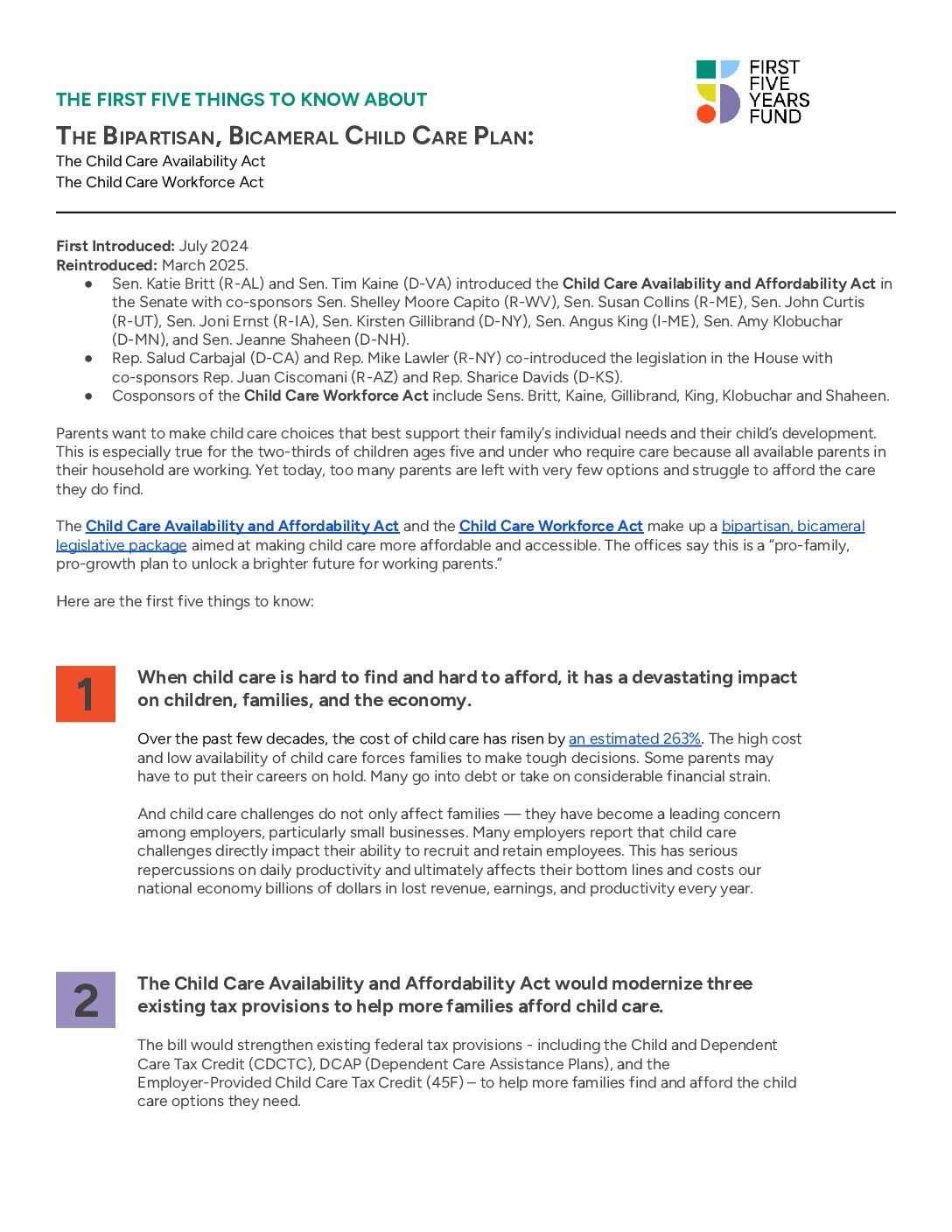The First Five Things to Know About: The Britt-Kaine Bipartisan Child Care Plan

First Introduced: July 2024
Reintroduced: March 2025.
- The Child Care Availability and Affordability Act was introduced in the Senate by: Sen. Katie Britt (R-AL), Sen. Tim Kaine (D-VA) with co-sponsors Sen. Jeanne Shaheen (D-NH), Sen. Joni Ernst (R-IA), Sen. Shelley Moore Capito (R-WV), Sen. Susan Collins (R-ME), Sen. John Curtis (R-UT), Sen. Kirsten Gillibrand (D-NY), Sen. Angus King (I-ME), Sen. Amy Klobuchar (D- MN), Sen. Thom Tillis (R-NC), Sen. Maggie Hassan (D-NH), Sen. David McCormick (R-PA), Sen. Mark Warner (D-VA), Sen. Tommy Tuberville (R-AL), Sen. Mark Kelly (D-AZ), Sen. Dan Sullivan (R-AK), Sen. Pete Ricketts (R-NE), Sen. Elissa Slotkin (D-MI), and Sen. Ruben Gallego (D-AZ).
- Rep. Salud Carbajal (D-CA) and Rep. Mike Lawler (R-NY) co-introduced the legislation in the House with cosponsors Rep. Sharice Davids (D-KS), Rep. Juan Ciscomani (R-AZ), Rep. Joe Neguse (D-CO), Rep. Greg Landsman (D-OH), Rep. Josh Harder (D-CA), Rep. Jim Costa (D-CA), Rep. Zachary Nunn (R-IA), Rep. Don Bacon (R-IA), Rep. Chrissy Houlahan (D-PA), Rep. Marie Gluesenkamp Perez (D-WA), Rep. David Valadao (R-CA), Rep. Frank Mrvan (D-IN), and Rep. Brian Fitzpatrick (R-PA).
- Cosponsors of the Child Care Workforce Act include Sens. Britt, Kaine, Gillibrand, King and Shaheen and Reps. Davids and Ciscomani.
Parents want to make child care choices that best support their family’s individual needs and their child’s development. This is especially true for the two-thirds of children ages five and under who require care because all available parents in their household are working. Yet today, too many parents are left with very few options and struggle to afford the care they do find.
The Child Care Availability and Affordability Act and the Child Care Workforce Act make up a bipartisan, bicameral legislative package aimed at making child care more affordable and accessible. The offices say this is a “pro-family, pro-growth plan to unlock a brighter future for working parents.”
Here are the first five things to know:

When child care is hard to find and hard to afford, it has a devastating impact on children, families, and the economy.
Over the past few decades, the cost of child care has risen by an estimated 263%. The high cost and low availability of child care forces families to make tough decisions. Some parents may have to put their careers on hold. Many go into debt or take on considerable financial strain.
And child care challenges do not only affect families — they have become a leading concern among employers, particularly small businesses. Many employers report that child care challenges directly impact their ability to recruit and retain employees. This has serious repercussions on daily productivity and ultimately affects their bottom lines and costs our national economy billions of dollars in lost revenue, earnings, and productivity every year.

The Child Care Availability and Affordability Act would modernize three existing tax provisions to help more families afford child care.
Strengthening existing federal tax provisions – including the Child and Dependent Care Tax Credit (CDCTC), DCAP (Dependent Care Assistance Plans), and the Employer-Provided Child Care Tax Credit (45F) – would help more families find and afford the child care options they need.

Here’s how that would work:
- The legislation would broaden the Child and Dependent Care Tax Credit (CDCTC) – the only tax credit that specifically helps parents pay for child care – by making the credit refundable for low- and middle-income working families and expanding the maximum amount parents can receive to $2,500 for families with one child and $4,000 for families with two or more children.
- It would strengthen Dependent Care Assistance Plans (DCAP) by increasing the amount of pre-tax dollars families can put into a child care assistance plan (similar to a Flexible Spending Account) from $5,000 to $7,500.
- And it would bolster the Employer-Provided Child Care Tax Credit (often referenced as 45F), supporting businesses who want to provide child care to their employees and allowing small businesses to work together to provide child care to employees.
- Here is an explainer of the three tax provisions.

The policies in the Child Care Availability and Affordability Act are popular with voters.
- In a 2025 poll, Americans said they overwhelmingly support (86%) expanding the Child and Dependent Care Tax Credit (CDCTC), including 83% of Republicans, 83% of Independents, and 91% of Democrats.
- They also strongly support expanding DCAP, including 86% of Republicans, 80% of Independents, and 83% of Democrats.
- And they strongly support expanding 45F, with 81% of Republicans, 76% of Independents, and 81% of Democrats approving.

The package also contains the Child Care Workforce Act, which would address early educator shortages by establishing a pilot program to boost the supply of child care workers.
- It would implement a competitive grant program for organizations interested in adopting or expanding pay supplement programs for child care workers to decrease turnover.
- Grantees would also be able to provide supplements to both home-based and center-based child care providers who are licensed by the state.
The Bottom Line
Pairing tax reform with robust federal investment to strengthen child care supports families with young children while ensuring greater economic stability across the country. This package provides an innovative way to increase the supply of quality child care, while looking for ways that providers can recruit and retain a highly-qualified workforce.
Learn More
- First Five Years Fund: Child Care and the Federal Tax Code resource kit;
- FFYF’s First Five Questions interview series featuring Sens. Katie Britt and Tim Kaine;
- First Five Years Fund Press Release
- Letters of Support for expanding child care-related tax provisions;
- 2025 polling with support for child care tax provisions;
- Axios, “Kaine, Britt tackle pricey child care in new bipartisan bills.”
Subscribe to FFYF First Look
Every morning, FFYF reports on the latest child care & early learning news from across the country. Subscribe and take 5 minutes to know what's happening in early childhood education.




